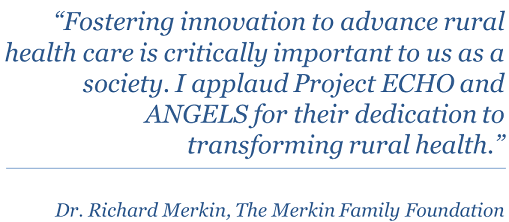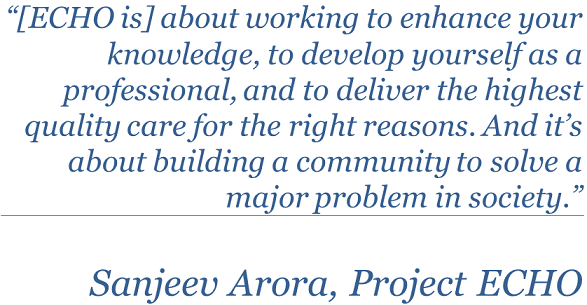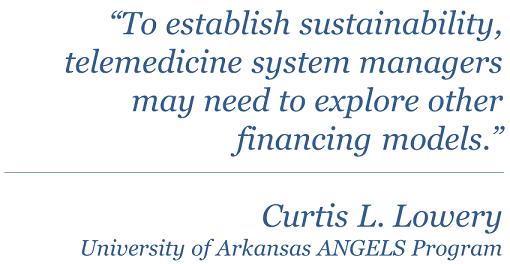Rural communities face significant challenges to health care delivery: long distances to many medical services; shortages of health professionals (65 percent of all Health Professional Shortage Areas are in rural areas); and populations that are older, have lower incomes, and tend to be in poorer health.1,2 Many payment initiatives have sought to address these challenges, including additional payments to support local hospitals and bonuses for physicians practicing in rural shortage areas, yet despite these initiatives, rural populations continue to experience substantial problems of access to high-quality care.
Many clinical leaders are pioneering innovations to enhance rural health care delivery through new technologies that provide the means to enhance communication and dissemination of knowledge. The Merkin Initiative on Payment Reform and Clinical Leadership recently hosted: MEDTalk: Transforming Rural Health through Telehealth and Education, where clinical leaders and payers discussed these emerging opportunities to improve health care for rural Americans, the payment reforms that would support these changes, as well as means of overcoming barriers to meaningful payment reform. The event featured leaders from two innovative programs: Project ECHO, which facilitates remote provider education by connecting specialists and primary care practitioners to improve rural health care; and ANGELS, which applies telemedicine and education to treating high-risk pregnancies, perinatal bereavement, stroke, and spinal cord injuries.

Innovating the Primary Care-Specialist Relationship
Due to geographic isolation, rural primary care providers (PCPs) often lack close connections to a network of other providers, which can leave them frustrated as they watch their patients travel long distances to see a specialist only after waiting months for an available appointment.3,4 Many delivery system transformations that aim to reduce these barriers for rural patients modernize the traditional relationship between PCPs and specialists. Instead of traveling to see a specialist, rural patients can receive care within their community from a PCP that obtained education or guidance from a specialist, or through a live connection with a specialist practicing remotely through audio and/or video conferencing.

Rural providers also face financial and technological constraints. While consultations with specialists at an urban academic medical center can be easily facilitated via “on-campus” in-person interactions with among frequently interacting colleagues, a reliable means of remote communication and newly established professional networks are required for rural providers. Further, current payment structures and financial pressures on rural hospitals5 may place an innovation like provider education at odds with the lost revenue of additional appointments during provider education activities.
Actions to Support Improved Rural Health Care
The MEDTalk discussions focused on key opportunities for using new technologies, especially communication technologies, to improve rural care, alongside feasible reforms in health care payments.
Leverage high- and low-tech innovations to provide optimal care: Advances in technology, like broadband, create new opportunities to address many of the gaps in rural access and quality of care. Telemedicine, electronic consultations, and virtual provider education focus on linking rural primary care providers to remote specialists based in distant locations to better care for patients. This gives rural patients more convenient and timely access to care and, in many cases, provides opportunities to reduce health care costs.

Align payment models to support delivery changes that optimize care: Traditional fee-for-service (FFS) health care payments generally cover in-person physician and specialist services, but they are not well suited to these new models of care. FFS payments often do not cover many of these transformations—including remote specialist services, telemedicine, and care coordination. While many of these services are high-value when delivered as part of an efficient process of care transformation, Medicare and other payers are concerned that broad new payments for “virtual” services may not be targeted well and thus may add to costs without improving health.
Alternative payment models such as per-member per month or partially bundled payments shared between rural and distant health care provider teams can support these delivery system changes while encouraging their use only in cases where they add value. For example, rural and specialist providers jointly receiving a partially bundled payment for the care of a patient’s chronic disease, could be used to cover the costs of effective data exchange and care coordination between them. Some aggregation of payment across providers would improve the support given to delivery transformations that strengthen inter-provider communication and education while encouraging accountability for the care teams to improve results.
Conclusion
Until payment models reinforce innovative delivery system reforms which optimize care and resources, isolated rural providers will continue to struggle even as their patients— often friends and neighbors—have to travel long distances to get access to specialty care. Rural hospitals are facing increasing pressures to identify payment and delivery transformations that improve and sustain care, as many rural hospitals are closing their doors.6 With ongoing demands on the rural health care workforce and a rapidly growing base of medical knowledge, supporting care transformations that leverage rather than isolate rural health care delivery will remain a critical area of health care reform.



Commentary
Opportunities to transform rural health care
December 17, 2014